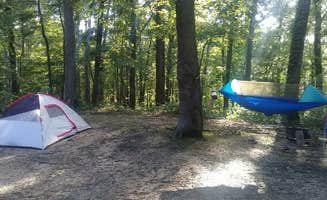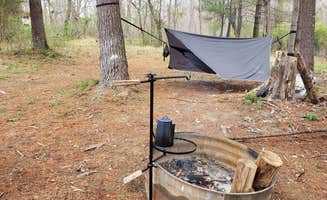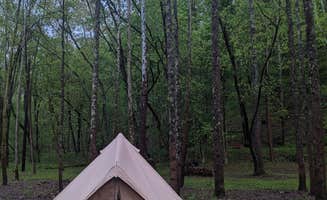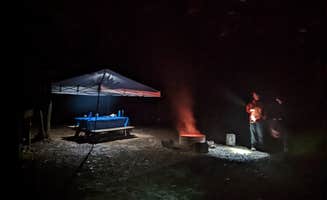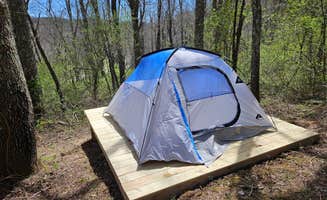Letart, West Virginia sits along the Ohio River at approximately 600 feet elevation with seasonal temperature swings from winter lows in the 20s to summer highs in the 80s. The surrounding region offers tent camping opportunities across both West Virginia and neighboring Ohio, with many sites located within Wayne National Forest's 250,000+ acres. Campers typically find more developed facilities on the Ohio side while West Virginia offers more primitive options.
What to do
Trail exploration: The Zaleski State Forest trail system provides multiple backpacking options ranging from short overnight trips to multi-day excursions. "The trail is diverse and great for beginners and experienced hikers. The campsites have privies, spigots for water, and a lot of different sites for different sized groups," reports Matt S.
Mountain biking: Benton's on the Baileys provides direct access to the Baileys Trail System with over 30 miles of purpose-built mountain biking trails. "This campsite is near the Baileys Bike System," notes Keith B., making it convenient for riders wanting early trail access.
Fishing opportunities: Timbre Ridge Lake offers bank and boat fishing opportunities for catfish and other species. Several small lakes throughout the region provide fishing access within short distances of camping areas. "There were fishermen coming and going several times through the night," observes Kenda A., highlighting the popularity of night fishing at some locations.
Shooting sports: The Chief Cornstalk Wildlife Management Area includes a public shooting range open during daylight hours. The range provides designated shooting stations with backstops for target practice, though users must bring their own targets and shooting supplies.
What campers like
Privacy and seclusion: The Baileys Trail Tent Camping area offers a sense of remoteness despite being relatively accessible. "Nice wide open space surrounded by woods. There were other campers but very friendly and had plenty of space to ourselves," writes Alex A.
Water availability: At backpacking campsites in Zaleski State Forest, the reliable water sources are highly valued. "All campsites have an outhouse and potable water all within easy reach from all camping areas," notes Bryn S. This eliminates the need to carry large quantities of water during summer hikes.
Wildlife viewing: The forests surrounding Letart host diverse wildlife populations including deer, wild turkeys, and various bird species. "We felt safe enough to leave our windows only screened," mentions Kenda A. about camping at Timbre Ridge Lake, where wildlife encounters are common.
Toilet facilities: Many primitive sites offer basic toilet facilities that campers appreciate despite their rustic nature. "Very nice bathroom/shower compared to what we expected," reports Alex A. about facilities at Baileys Trail Tent Camping, which exceed expectations for a rustic campground.
What you should know
Limited reservations: Most dispersed camping areas operate on a first-come, first-served basis. Popular backpacking sites fill quickly on weekends, especially in spring and fall. Arrive by mid-afternoon on Fridays for best site selection at non-reservable locations.
Water treatment needs: While some established campgrounds provide potable water, many primitive sites require campers to bring or filter their own. "Water is definitely well water tastes meh better off bringing a filter just in case," advises Lani R. from Zaleski State Forest.
OHV traffic: The Monday Creek OHV Dispersed area can experience significant vehicle noise during peak times. "Lots of trucks and toy haulers heading up the various roads into the late evening," reports Kevin C., suggesting that light sleepers should consider camping further from main access roads.
Cell service limitations: Most camping areas near Letart have limited or no cell reception. Download maps and information before arrival, especially for backcountry sites. "NO SERVICE PLAN ACCORDING make sure you have a map especially to get out of the park!!!!" emphasizes Lani R. about Zaleski Forest.
Tips for camping with families
Age-appropriate trails: The Pine Knob Loop Campground area offers hiking suitable for younger children. "Lots of fun and a good hike - easy enough for an 8 year old!" shares Carri D., indicating the trails are manageable for elementary school-aged kids.
Multiple day options: Zaleski State Forest's loop system allows families to customize hike lengths. "We did the South Loop at Zaleski - 10.9 miles. The hike was great. Lots of ups & downs, a pond & beautiful rock outcroppings," reports Renée C., who successfully completed the hike with an 8-year-old.
Educational opportunities: Visit the Athens Ranger District headquarters before camping to obtain junior ranger materials and educational resources about local ecology. The visitor center includes displays about local wildlife and plant species that can enhance children's outdoor experience.
Pack extra supplies: Facilities at many sites are minimal, requiring advance preparation. "Bring toilet paper" advises Renée C. based on her family backpacking experience, as even established outhouses may not be stocked regularly.
Tips from RVers
Limited hookup options: Most camping near Letart lacks electric, water, or sewer hookups. RVers should prepare for dry camping with adequate water storage and battery power. Generators are typically not permitted at primitive sites.
Access challenges: Many forest roads leading to camping areas have steep grades, tight turns, or rough surfaces. Larger trailers and motorhomes may have difficulty accessing remote sites, particularly after rain events when unpaved roads become slippery.
Alternatives for larger rigs: Camp Rotan provides one of the few accessible options for RVs in the immediate area, though it lacks formal amenities. "It's quite overgrown and unmaintained. Not many amenities, and is near residential housing," notes Ruby W., suggesting it works better for smaller, self-contained units.
Parking limitations: Most tent-focused camping areas have limited parking space that may not accommodate larger vehicles or trailers. Scout locations in advance or contact ranger stations for specific information about vehicle length restrictions.


